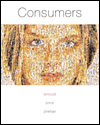This chapter concentrates on the meanings of consumption, which we describe
as central to understanding consumer demand for products (goods, services, experiences,
and ideas). To understand this process we first introduce the idea of semiosis,
or the nature of meaning. We describe what meaning is and how it attaches to
objects. We point out that consumption involves both individual meanings and
social ones. In the next section we explore five types of consumption meanings
that may be derived from products: utilitarian, sacred and secular, hedonic,
and social. Often these overlap in a single product, yet specific meanings associated
with a product may vary between market segments. In the next four sections of
the chapter we describe the origin and movement of meanings, using the meaning
transfer model to organize this discussion. First we describe the origin of
meaning in the culturally constituted world explaining the role of cultural
principles and categories in organizing meaning. Next, we describe how culturally
available meanings are linked to products through the advertising and fashion
systems. Various techniques and rhetorical (persuasive) strategies are described
in detail including advertising formats and literary devices. The role of various
participants in the meaning transfer process including spokespersons, copy writers,
and designers are described. The roles that consumers play in interpreting and
assimilating advertising meanings are also explored. In the next section of
the chapter, we describe two kinds of consumer meaning transfer processes. Both
ordinary behaviors and ritualized ones are discussed, both of which are employed
to extract meaning from the world of goods. The next section discusses the inherent
malleability of consumer meanings. Our purpose here is to point out that there
is inherent dynamism in consumer meanings. Meanings fluctuate both within and
between market segments. Some of the processes through which consumers debate
the significance of goods are described. In the next section of the chapter
we discuss the significance of collecting, a peculiar and economically significant
vehicle for the consumption of meaning. Collecting provides consumers with important
opportunities to experience hedonic and sacred meanings and to engage in possession
and exchange rituals. We discuss both individual and institutional collecting,
especially as conducted by museums. To conclude we discuss several dimensions along which consumption meanings
vary cross-culturally. We point out that cataloguing all possible consumption
meanings is impossible, given the fluid quality of demand in a global economy.
Nonetheless, seeking to manage the apparently universal human propensity to
invest products with meaning requires that marketers pay attention to the ever-shifting
play of cultural meanings. |




 2002 McGraw-Hill Higher Education
2002 McGraw-Hill Higher Education


 2002 McGraw-Hill Higher Education
2002 McGraw-Hill Higher Education